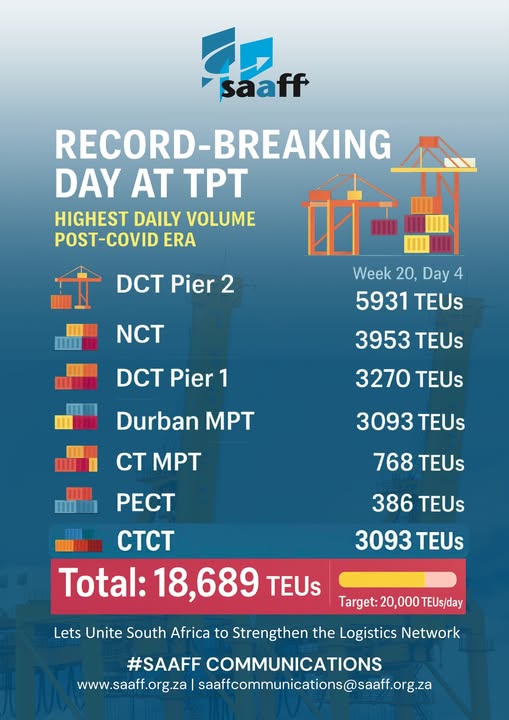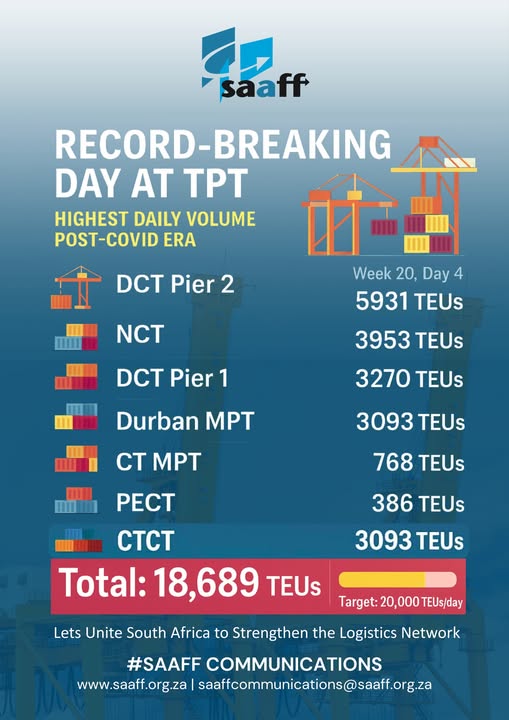South Africa ports break daily cargo volume record in August amid reforms push
- South Africa ports moved up to 18,689 Twenty-Foot Equivalent Units (TEUs) in a single day in August despite continued challenges of ageing infrastructure that often leads to processing delays.
- The record volume in cargo handled was the highest since the Covid-19 pandemic that triggered massive dip in port operations.
- Southern African Association of Freight Forwarders CEO Dr. Juanita Maree says deployment of new equipment, reforms in cargo handling processes, and partnerships is helping stabilize port performance.
In August, ports across South Africa defied the odds posting record daily volume in the sector by moving up to 18,689 Twenty-Foot Equivalent Units (TEUs) despite continued challenges of ageing infrastructure that often leads to processing delays.
In an update to stakeholders, the Southern African Association of Freight Forwarders (SAAFF), the record volume in cargo handled was the highest since the Covid-19 pandemic that triggered massive dip in port operations.
SAAFF chief executive Dr. Juanita Maree said the record cargo volume was met across the Transnet-managed terminals during week 20 of the organizations fiscal year.
“The last 24 months have been challenging, but with new equipment, amended processes, and collective effort, port performance is stabilizing. This is not the success of one, but of many – SAAFF members and industry partners have played a vital role in this journey,” explained Dr. Maree.
South Africa’s port performance is gradually stabilizing
She noted that with the deployment of new equipment, reforms in cargo handling processes, and partnership with players in the segment, South Africa’s port performance is gradually stabilizing.
During the record month, disclosures on all Transnet Port Terminals (TPT) show that Durban Container Terminal (DCT) Pier 2 reported the highest volume at 5,931 TEUs, closely followed by Ngqura Container Terminal with 3,953 TEUs, Durban Pier 1 with 3,270 TEUs, Cape Town port with 3,093 TEUs Durban MPT at 1,288 TEUs, Cape Town MPT (768 TEUs), and Port Elizabeth with 386 TEUs.
The turnaround in volume comes at a time when ports across Africa’s most advanced economy have been grappling with ageing infrastructure amid rising cargo volumes, inordinate delays in processing goods, as well as limited capacity.
These challenges have seen shipping lines and importers incur higher costs, thereby impacting on the cost of business.
According to Dr. Maree, however, the new benchmark in cargo volume is a pointer to resilience in operations and continued partnership across players in South Africa’s value chain.
SAAFF CEO observed that to enhance output, stakeholders in the value chain industry need to explore initiatives such as berth deepening, development of the Natcor/Central Corridor rail linkage.
During the month under review, media reports show that Transnet Port Terminals disclosed that Ngqura Container Terminal (NCT) set weekly records in volume, handling 15,671 TEUs in Week 19 (04–10 August). What’s more, it managed to handle historic 21,480 TEUs in Week 20 (11–17 August), reflecting the highest volume ever handled north of its weekly target of 14,614 TEUs.
“This achievement reflects the resilience, collaboration, and determination of our logistics community, port operators, and industry stakeholders. While just shy of the 20,000 TEU target, this sets a powerful benchmark for continued improvement in port performance,” SAAFF announced.

Reforms in South Africa’s Port System
According to South Africa’s Department of Transport, authorities have put forward for consideration a new policy framework aimed at revving up operations of the country’s ports business.
Dubbed Comprehensive Maritime Transport Policy (the CMTP) for South Africa, this document aims at enabling the growth and development of the country’s maritime transport system, which is a key pillar in sustaining international trade.
CMTP envisions “maritime transport” as “an integrated system that involves the design, construction, operation, management, servicing and maintenance of merchant, leisure and other ships in the service of seaborne trade.”
Additionally, the policy document seeks to encompass logistics systems across land including road and railway, corridors that are vital in enabling faster movement of both people and goods through seamless connection with the ports.
Port reforms in South Africa have been in the works since the publishing of the country’s White Paper on National Transport Policy in 1996, an undertaking that seeks to address a myriad of issues such as costs, and inefficiencies in operations.
In particular, CMTP proposes “massive investment in infrastructure, innovative technology, proper management and a clear understanding of their evolving role in a globalizing world economy.” The reforms aim at reviewing the country’s Commercial Ports Policy of 2002, introduction of port land use spatial planning and the deployment of tools to enhance monitoring and evaluating the input of private sector players in port operations.
Read also: Why Africa must build resilient supply chains—fast
Share this content:





Post Comment